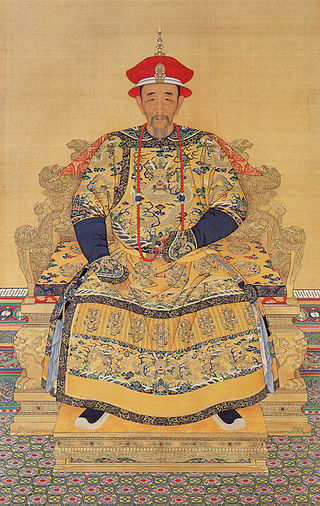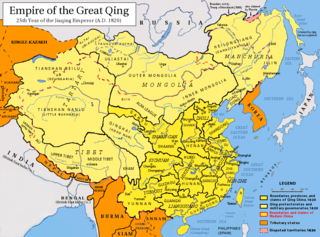
The Mongols are an East Asian ethnic group native to Mongolia, Inner Mongolia in China, and the Republic of Buryatia of the Russian Federation. The Mongols are the principal member of the large family of Mongolic peoples. The Oirats in Western Mongolia as well as the Buryats and Kalmyks of Russia are classified either as distinct ethno-linguistic groups or subgroups of Mongols.

The Chahars are a subgroup of Mongols that speak Chakhar Mongolian and predominantly live in southeastern Inner Mongolia, China.

The Kangxi Emperor, also known by his temple name Emperor Shengzu of Qing, personal name Xuanye, was the third emperor of the Qing dynasty, and the second Qing emperor to rule over China proper, reigning from 1661 to 1722.

The Qianlong Emperor, also known by his temple name Emperor Gaozong of Qing, personal name Hongli, was the fifth emperor of the Qing dynasty and the fourth Qing emperor to rule over China proper. The fourth son of the Yongzheng Emperor, he reigned officially from 11 October 1735 to 8 February 1796. In 1796, he abdicated in favour of his son, the Jiaqing Emperor, out of filial piety towards his grandfather, the Kangxi Emperor, who ruled for 61 years, so that he would not officially usurp him as the longest-reigning emperor. Despite his retirement, however, the Qianlong Emperor retained ultimate power as the Emperor Emeritus until his death in 1799, making him one of the longest-reigning monarchs in history as well as one of the longest-lived, dying at age eighty-seven. During his lifetime, he was given the deified title "Emperor Manjushri" by the Qing's Tibetan subjects.

Hong Taiji, also rendered as Huang Taiji and sometimes referred to as Abahai in Western literature, also known by his temple name as the Emperor Taizong of Qing, was the second khan of the Later Jin dynasty and the founding emperor of the Qing dynasty. He was responsible for consolidating the empire that his father Nurhaci had founded and laid the groundwork for the conquest of the Ming dynasty, although he died before this was accomplished. He was also responsible for changing the name of the Jurchen ethnicity to "Manchu" in 1635, and changing the name of his dynasty from "Great Jin" to "Great Qing" in 1636. The Qing dynasty lasted until 1912.

The Dzungar Khanate, also written as the Zunghar Khanate or Junggar Khanate, was an Inner Asian khanate of Oirat Mongol origin. At its greatest extent, it covered an area from southern Siberia in the north to present-day Kyrgyzstan in the south, and from the Great Wall of China in the east to present-day Kazakhstan in the west. The core of the Dzungar Khanate is today part of northern Xinjiang, also called Dzungaria.

The Khalkha or Kalka have been the largest subgroup of Mongol people in modern Mongolia since the 15th century. The Khalkha, together with Chahars, Ordos and Tumed, were directly ruled by Borjigin khans until the 20th century; unlike the Oirats, who were ruled by Dzungar nobles or the Khorchins, who were ruled by Qasar's descendants.
Yangsanjab, Prince Öndür, was a Mongol prince of the Khorchin Left Wing Middle Banner in southeastern Mongolia. He was one of the leading figures in the resistance against Han colonization of Mongolia. Unlike Ghada Meyiren, he is rarely spotlighted, probably because he was from the ruling class and does not fit the Marxist framework of class struggle.
Khutugtu Khan, born Ligdan, (1588–1634) was a khagan of the Northern Yuan dynasty, reigning from 1604 to 1634. During his reign, he vigorously attempted to reunify the divided Mongol Empire, achieving moderate levels of success. However, his unpopular reign generated violent opposition due to his harsh restrictions over the Mongol tribes as he attempted to centralize the state. His alliance with the Ming dynasty, sponsorship of Tibetan Buddhism in Chakhar and the reorganization of Mongol political divisions were ineffective when the Later Jin dynasty became the major power in East Asia.
The Qing dynasty (1636–1912) of China developed a complicated peerage system for royal and noble ranks.

Mongolia under Qing rule was the rule of the Manchu-led Qing dynasty of China over the Mongolian Plateau, including the four Outer Mongolian aimags and the six Inner Mongolian aimags from the 17th century to the end of the dynasty. The term "Mongolia" is used here in the broader historical sense, and includes an area much larger than the modern-day state of Mongolia. Ligdan saw much of his power weakened due to the disunity of the Mongol tribes. He was subsequently defeated by the Later Jin dynasty and died soon afterwards. His son Ejei handed the Yuan imperial seal over to Hong Taiji in 1635, thus ending the rule of the Northern Yuan dynasty in Inner Mongolia. However, the Khalkha Mongols in Outer Mongolia continued to rule until they were overrun by the Dzungar Khanate in 1690, and they submitted to the Qing dynasty in 1691.

The Mongolian nobility arose between the 10th and 12th centuries, became prominent in the 13th century, and essentially governed Mongolia until the early 20th century.

The Qing dynasty of China ruled over the Mongolian Plateau, including Inner Mongolia and Outer Mongolia. Both regions, however, were separately administered within the empire.

The Northern Yuan was a dynastic regime ruled by the Mongol Borjigin clan based in the Mongolian Plateau. It existed as a rump state after the collapse of the Yuan dynasty in 1368 and lasted until its conquest by the Jurchen-led Later Jin dynasty in 1635. The Northern Yuan dynasty began with the retreat of the Yuan imperial court led by Toghon Temür to the Mongolian steppe. This period featured factional struggles and the often only nominal role of the Great Khan.
The Upper Mongols, also known as the Köke Nuur Mongols or Qinghai Mongols, are ethnic Mongol people of Oirat and Khalkha origin who settled around the Qinghai Lake in so-called Upper Mongolia. As part of the Khoshut Khanate of Qaidam Basin and the Qinghai Lake, they played a major role in Sino–Mongol–Tibetan politics during the 17th and 18th centuries. The Upper Mongols adopted Tibetan dress and jewelry despite still living in the traditional Mongolian ger and writing in the script.
Various nomadic empires, including the Xiongnu, the Xianbei state, the Rouran Khaganate (330–555), the First (552–603) and Second Turkic Khaganates (682–744) and others, ruled the area of present-day Mongolia. The Khitan people, who used a para-Mongolic language, founded an empire known as the Liao dynasty (916–1125), and ruled Mongolia and portions of North China, northern Korea, and the present-day Russian Far East.
Anti-Mongolianism, also called the Anti-Mongolian sentiment has been prevalent throughout history, often perceiving the Mongols to be barbaric and uncivilized people with a lack of intelligence or civilized culture.

The Qing dynasty in Inner Asia was the expansion of the Qing dynasty's realm in Inner Asia in the 17th and the 18th century AD, including both Inner Mongolia and Outer Mongolia, both Manchuria and Outer Manchuria, Tibet, Qinghai and Xinjiang.
Yoto was a Qing dynasty imperial prince and Nurhaci's grandson. Yoto became the first bearer of the Prince Keqin peerage as Prince Cheng of the First Rank. He was demoted two ranks for committing a grave offence and posthumously granted a title of Prince Keqin of the Second Rank. After his death, the peerage was twice renamed until 1778, when the peerage was granted iron-cap status, which meant that each successive bearer of the title would hold undiminished title vis-a-vis his predecessor.
Šose was Hong Taiji's fifth son and the first bearer of the Prince Chengze title. In 1655, the peerage was renamed to Prince Zhuang of the First Rank. In 1778, the Prince Chengze of the First Rank peerage was granted iron-cap status, which meant that each successive bearer could pass the title without degradation.











